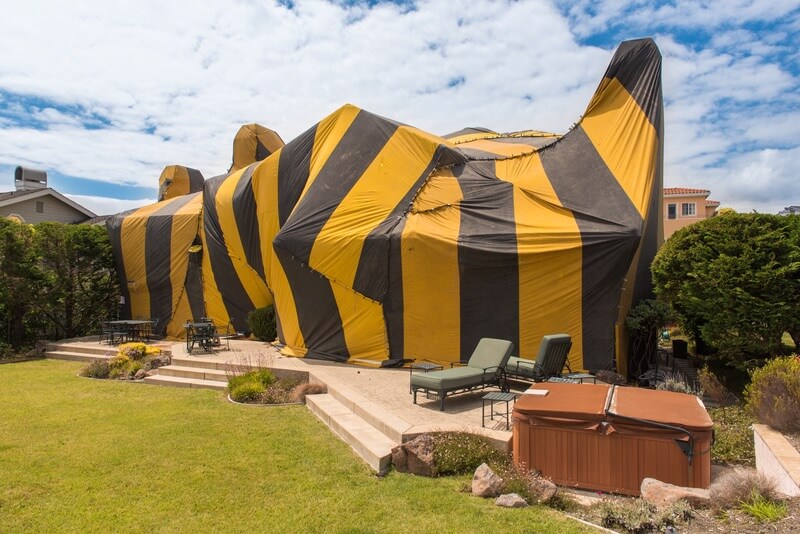Termite tenting is a unique and effective method of dealing with a serious termite infestation in your home. But because it’s such an extreme process, many people don’t know what to expect!
This guide will go over everything you need to know when it comes to termite tenting. You’ll learn about its effectiveness, how to prepare, and how long the process lasts.
Table of Contents
What Is Termite Tenting?
Termite tenting seems like an extreme way to get rid of pests, but it can be a necessary plan of attack that can provide good results. This treatment method targets drywood termites specifically, which are notoriously difficult to get rid of because of their behavior as wood-boring insects. Unlike subterranean termites, treating the soil and spraying insecticides won’t cut it.
Unfortunately, termites can do a lot of damage by the time you’ve seen the signs. They can ruin entire structures, setting homeowners back thousands of dollars in repair. There already could be significant damage by the time you realize termites are a problem.

The termite tenting process, also called fumigation, is a fascinating process you can’t miss. As the name implies, it involves covering your entire home in a massive tent. Most fumigation companies use brightly colored tents you’ll spot a mile away!
- Kills the termites you see, and the ones you don’t see
- The foam expands at a 30:1 ratio to fill cracks
- Get the hard-to-reach areas with ease
- Can be used indoors and outdoors
But those gawdy tents serve a valuable purpose. Because drywood termites burrow in the wood they eat, you can’t treat them by spraying liquid products. Instead, you have to utilize chemical fumes.
After tenting your entire home, technicians seal the structure and release a fumigant. The toxic chemicals seep into every nook, cranny, and crack that termites could use to evade traditional pesticides. It’s an effective way to kill existing termites.
There is a variation to traditional termite tenting that involves heat. Instead of fumigation, pest control experts might recommend a heating technique. The home still requires tenting, but the tent’s purpose is to lock in heat.
Raising the temperature beyond 100 degrees inside the home will kill termites without the harsh chemicals.
Modern tentless termite treatments are available, too. They utilize less dangerous fumigants, eliminating the preparation and sealing.
The alternatives can be beneficial, but traditional tenting and fumigation tend to be the go-to for serious infestations.
How Effective Is It?
Termite tenting and fumigation are rather effective methods. The fumigants work on a few different levels. Once the fumes fill your home, they effectively cut off the oxygen supply for termites. But that’s not all.
The chemicals also wreak havoc on the termite’s central nervous system. It doesn’t take long for the pests to die completely.
The most significant benefit of termite tenting is that you don’t have to focus on specific areas. Drywood termites are notorious for getting into discrete nooks and crannies. They burrow deep into the wood, making traditional pesticide applications ineffective.
Subterranean termites are easy to treat by focusing your attention on the soil. But drywood varieties aren’t so easy. Tenting is a long and arduous process, but it’s the best way to get rid of termites and save your home.
How To Prepare For Termite Tenting
Before the tenting process, there is some preparation that you’ll need to do. It all starts with a consultation. A technician will go through your home, inspect the issue, and recommend a suitable course of action.
If they decide that tenting is necessary, they’ll let you choose a date. It’s important to be realistic and give yourself plenty of time to prepare for the process.
1. Stop Buying Food
Try to choose a date that’s several weeks away. Why? Not only do you have ample time to make arrangements, but it can help you work through as much of your current food supply as you want.
Stop buying food and use what you have in your pantry, refrigerator, and freezer. The goal is to make your job easier as the tenting process draws near. One of the most frustrating parts of termite tenting preparation is removing food.
By working through your current food supply, you can minimize how much food you have to move later.
2. Make Living Arrangements
How long the termite tenting process takes will depend entirely on the size of your home and the extent of the infestation. At the very least, it will take around 24 hours (more on this later). However, it’s not uncommon for treatment to take several days or up to a week!
That means one of the most important parts of preparing for termite tenting is to make smart living arrangements to minimize this process’s impact on your life. You can’t stay in your home as the fumigant does its work, so you’ll need to stay with friends, family, or rent a place.
3. Remove Perishable Food & Plants
In the days leading up to your tenting date, you want to remove every piece of food from your home.
While you could double bag products to prevent the chemicals from getting into your food, most experts recommend removing things to be on the safe side.
You can leave behind canned foods in your pantry. Fumigant doesn’t leave behind residue that can stick to cans. Plus, the food inside is completely sealed off from the air.
Expert Tip: Don’t forget to take your houseplants as well. They will die if you leave them behind!
4. Take Out Linens
Here’s a commonly overlooked step in the preparation process. Many homeowners fail to remove their bedding and linens before termite tenting. While fumigant doesn’t usually leave residue behind, it can linger in fabrics.
Leaving bedding behind could result in a faint smell. Unless you want to wash everything when you get back, it’s best to take linens out or seal them in storage bags.
5. Shut Off Gas
Your home is already going to have noxious fumes during this treatment process. Adding natural gas or propane to the mix could be dangerous.
Always turn your gas utilities off before your scheduled termite tenting. If you have propane, cutting gas to the house is pretty straightforward. But for homes with natural gas, you might have to contact your service provider.
6. Turn Off & Unplug Potentially Dangerous Items
It’s not just the gas you have to worry about when preparing for the termite tenting process. Your home likely has many gadgets and appliances that have built-in heating elements. For example, you might have space heaters, hair dryers, and other objects that could potentially start a fire.
When your home is filled with gas, the last thing you want to worry about is a potential fire hazard. Unplug all those items to ensure that your home stays safe.
7. Unlock Doors & Cabinets
Finally, don’t forget to unlock doors and cabinets. This preparation step allows technicians to get into every room and closed-off space. Even lockable cabinets should be open so that the fumes can get everywhere.
Leaving doors locked can prevent technicians from doing their job, rendering the entire endeavor useless.
What Needs To Be Removed When Tenting For Termites?
The most important things to remove are yourself, your family, and any pets you might have. That includes dogs, cats, and even fish! Don’t assume that any living thing is safe because the fumes will cause trouble.
- Kills the termites you see, and the ones you don’t see
- The foam expands at a 30:1 ratio to fill cracks
- Get the hard-to-reach areas with ease
- Can be used indoors and outdoors
No one can be in the house as the fumes fill the living space.
It’s also essential to remove food and plants. Plants will die from the chemicals, and food will become inedible.
Many pest control experts recommend moving linens as well to ensure that no residue or odor remains when you return. It’s also a good idea to consider removing valuables for safekeeping.
Expert Tip: You don’t have to remove every piece of furniture. Contrary to what many think, the fumigant doesn’t leave behind residue. The odor can stick to fabrics, but your furniture isn’t a problem.
How Long Does Tenting for Termites Last?
Depending on the size of your house and the severity of the infestation, termite tenting can last anywhere between 24 hours to a week on average.
That’s why it’s a good idea to give yourself some time to prepare and remove any essential items before the process begins. Simply finding suitable living arrangements could be a challenge in itself!
How Safe Is It?
The process of termite tenting itself is pretty dangerous if you don’t follow the proper protocol. The chemicals can cause harm to humans, but that’s why tenting occurs in the first place.
A well-placed tent will prevent the gasses from escaping the treatment area. As long as no one is in the home, it’s entirely safe for you and your neighbors.
Exterminators also take extra precautions to prevent issues. For example, most treatment providers use leak detectors to ensure that the tent is sealed completely.
Afterward, your home will need to air out for several hours before you can enter. Fumiscopes help measure gas concentration during and after the process. A clearance device will ensure that gas concentrations are virtually undetectable before you enter.
Following these steps makes the fumigation process quite safe, so you can get treatment without worry.
How Much Does It Typically Cost?
Prices can vary dramatically depending on the size of your home. But always expect it to be a bit steep.
Termite tenting is very effective at removing existing infestations. However, it’s an extensive process that requires a lot of work.
On the lower end, you might pay around $1,000. However, larger homes can pay $4,000 or more. It all depends on the severity of the issue and the size of home.
A fumigation company should be able to provide an accurate estimate after doing a consultation.
Conclusion
Now that you’re familiar with the termite tenting process, it’s up to you to take the next steps. To make things easier, we recommend talking with a pest control company to see if the severity of your infestation warrants tenting or another form of removal.
If you’re considering tenting your home to get rid of termites and still have some questions, let us know! We’re more than happy to help.



